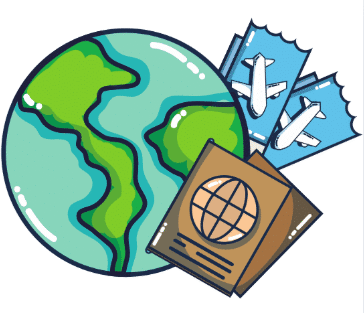Traveling across the USA can be a dream come true, but it can also become a financial burden if you’re not careful. In this article, I’m excited to share practical tips and strategies that I’ve found useful for unlocking smart savings and making travel more affordable. Whether you’re looking for cheap flights, budget accommodations, or great activities without breaking the bank, I’ve got you covered. Let’s dive in!
Understanding Travel Costs
To save money on travel, it’s essential to grasp what drives the costs. Here’s a breakdown of the primary expenses you might encounter:
- Transportation: This includes flights, car rentals, public transport, and gas.
- Accommodation: Hotels, motels, hostels, and short-term rentals can vary widely in price.
- Food: Dining out versus cooking can significantly impact your budget.
- Activities: Entrance fees, tours, and other entertainment options will also factor into your overall costs.
Finding Cheap Flights
One of the most significant expenses on any trip is usually the airfare. To cut costs, consider the following:
1. Be Flexible with Travel Dates
Airfare prices fluctuate based on the time of year, day of the week, and even time of day. If you can, try to be flexible with your dates. Often, flights that leave on Tuesday or Wednesday are cheaper than those on weekends.
2. Use Flight Comparison Websites
Websites like Skyscanner allow you to compare prices across multiple airlines and find the best deals. Always check several platforms, as prices can vary.
3. Subscribe for Alerts
Many travel websites, including Kayak, offer price alert features. Sign up for these alerts to be notified when prices drop on your desired routes.
Budget Accommodations
Finding a place to stay doesn’t have to cost a fortune. Here’s how to secure budget-friendly accommodations:
1. Consider Alternative Options
- Hostels: Ideal for solo travelers or those comfortable with shared spaces.
- Vacation Rentals: Websites like Airbnb often provide better deals than hotels, especially for larger groups.
- Couchsurfing: For the adventurous traveler, this free option allows you to stay with locals.
2. Book in Advance
Whenever possible, book your accommodations ahead of time. Many places offer discounts for early bookings. Aim for at least a month in advance, especially during peak travel seasons.
3. Leverage Loyalty Programs
Frequent travelers should consider joining hotel loyalty programs. These programs often offer discounts, free nights, and other perks that can lead to significant savings.
Smart Dining Choices
While it’s tempting to indulge in local cuisine, food costs can quickly add up. Here are some strategies to manage your dining expenses:
1. Eat Like a Local
Instead of dining at tourist hotspots, seek out local delis, food trucks, or grocery stores. Not only will you save money, but you’ll also get a taste of authentic local flavors.
2. Consider Meal Prepping
If you have access to a kitchen, consider preparing some meals yourself. This can drastically reduce your food costs and allow you to enjoy healthier options.
3. Look for Lunch Specials
Many restaurants offer lunch specials at lower prices compared to dinner menus. If you’re okay with dining earlier in the day, this can be a great way to enjoy a nice meal for less.
Affordable Activities and Attractions
There’s no need to spend a fortune on activities during your trip. Here’s how to have fun without breaking the bank:
1. Research Free Events
Before you go, research local festivals, free concerts, or community events that may be taking place during your visit. Websites like Eventbrite can be helpful for finding free or inexpensive activities.
2. Take Advantage of City Passes
If you’re visiting a larger city, consider purchasing a city pass. These passes often provide access to several attractions at a discounted rate, saving you money on entry fees.
3. Explore Nature
Many national parks and natural attractions have minimal entrance fees. If you enjoy hiking or exploring the outdoors, this can be a fantastic way to spend your days without spending much at all.
Travel Insurance: Is It Worth It?
Travel insurance is an additional expense, but it can save you money in the long run if something goes wrong. Here’s why you might consider investing in it:
- Cancellations: If your plans change unexpectedly, insurance can reimburse you for non-refundable expenses.
- Medical Emergencies: Should you face health issues while traveling, insurance can cover significant medical bills.
- Baggage Protection: Insurance can offer coverage if your belongings go missing or get damaged.
Maximizing Rewards and Points
If you travel frequently, it’s smart to take advantage of rewards programs. Here’s how you can maximize your savings:
1. Use Travel Credit Cards
Many credit cards offer travel rewards that can be redeemed for flights, accommodations, and more. Make sure to choose a card without significant annual fees and that aligns with your travel habits.
2. Join Airline Loyalty Programs
Becoming a member of an airline’s loyalty program can earn you miles with every flight. Look out for promotions that allow you to earn additional points to reach your goals faster.
Planning Your Itinerary Wisely
Having a solid itinerary can help you save time and money while traveling. Here’s how to plan effectively:
1. Prioritize Must-See Attractions
Make a list of attractions you absolutely want to see. From there, you can prioritize them based on location, ensuring you maximize your time and reduce transportation costs.
2. Organize Your Travel Routes
Plan your daily activities in proximity. For example, if you’re visiting a museum, look for nearby restaurants and shops you can explore without traveling far.
3. Consider Public Transport
Using buses, trains, or subways can significantly cut down on travel expenses. Often, cities offer transport passes that can be economical for multiple travels within a short period.
Capturing Memories on a Budget
When traveling, it’s important to capture your experiences without spending a fortune. Here are some inexpensive or free options for preserving memories:
1. Use Your Smartphone
Your smartphone camera is likely quite powerful. Use it to take photos and create a travel blog or journal without needing expensive gear.
2. Create a DIY Travel Book
When you return home, consider printing pictures and creating a scrapbook. This is a much cheaper alternative to professional photography or expensive coffee table books.
3. Share Your Experiences Online
By sharing your travel stories and photos on social media or travel blogs, you can revisit your memories without spending money on memorabilia.
Embrace Off-Peak Travel
If your schedule allows, consider planning your trips during off-peak seasons. Here’s why this can be beneficial:
- Better Prices: Flights and accommodations are typically cheaper during these times.
- Fewer Crowds: Popular attractions will be less crowded, making for a more enjoyable experience.
- More Availability: You’ll have more options when booking activities or dining without the need for reservations.
Connecting with Local Communities
Sometimes, the best travel experiences come from connecting with locals. Here’s how to do that:
1. Attend Local Meetups
Websites like Meetup.com can connect you with locals who share similar interests. This can be a great way to learn about the area, find free activities, and meet new people.
2. Take a Free Walking Tour
Many cities offer free (or donation-based) walking tours led by locals. These tours provide insight into the culture and history of the area while allowing you to explore more without spending a dime.
3. Dine at Local Households
Services like EatWith allow you to enjoy meals prepared by local chefs in their homes. This offers a unique perspective on the local culture, often at a fraction of the price of restaurant dining.
Final Touches for Smart Travel Savings
As you embark on your journey to explore the USA, remember that every dollar saved is useful for future travel adventures. Here are a few last tips:
- Track Your Expenses: Keep a travel budget to ensure you’re aware of your spending and can adjust as necessary.
- Ask for Discounts: Don’t hesitate to inquire about student, military, or group discounts wherever you go.
- Be Adventurous: Sometimes the best experiences come from spontaneity, and they may just be waiting for you to discover them.
By applying these smart saving strategies, you can enjoy the vast beauty and adventures of America without straining your budget. Now, go out there and start planning your next affordable adventure!
“`
Traveling in the USA doesn’t have to break the bank. With the right strategies, I’ve found ways to explore this vast country while keeping my expenses low. In this article, I’ll share my tips on how to unlock smart savings, explore various destinations, and shop for the best deals to make my travels cheaper and more enjoyable. Let’s dive into the best practices that can help you save money while traveling across the USA.
Frequently Asked Questions
What are the best times to visit the USA for cheaper travel?
The best times to visit the USA for cheaper travel often fall during the shoulder seasons, which are typically spring (April to June) and fall (September to November). During these months, you’ll find fewer crowds and better deals on accommodations and flights.
How can I save money on flights within the USA?
To save money on flights within the USA:
- Book in advance to find better deals.
- Use flight comparison websites.
- Be flexible with your travel dates and airports.
- Sign up for fare alerts from airlines and travel websites.
Are there cheaper alternatives to hotels?
Yes, alternatives to hotels include:
- Vacation rentals through platforms like Airbnb.
- Hostels for budget-conscious travelers.
- Staying with friends or family.
- Camping or staying at budget motels.
How do I find discount travel packages?
I usually find discount travel packages by researching on travel websites, subscribing to newsletters, and utilizing travel apps that offer package deals.
What apps can help me find cheap travel deals?
Some apps that can help find cheap travel deals include:
- Skyscanner for flights
- HotelTonight for last-minute hotel deals
- Hopper to predict the best times to buy flights
- Kayak for comparing prices
How can I save on food while traveling?
To save on food, I recommend:
- Eating at local diners or food trucks instead of fancy restaurants.
- Shopping at grocery stores for meals.
- Taking advantage of lunch specials.
- Using apps like Too Good To Go to find discounted meals.
Is it better to road trip or fly within the USA?
This often depends on your destination and travel style. Road tripping can be more cost-effective if traveling with a group and allows for sightseeing along the way. Flying can save time for longer distances.
What activities can I enjoy for free in the USA?
There are many free activities you can enjoy, such as:
- Visiting national parks
- Exploring local beaches and hiking trails
- Attending free festivals and events
- Exploring free museums or historical sites on certain days
How do I get discounts on attractions?
I get discounts on attractions by checking online for coupons and promotional codes. Also, many cities offer discount passes that bundle attractions at a lower rate.
What are the best websites for booking cheap accommodations?
Some reliable websites to book cheap accommodations include:
- Booking.com
- Expedia
- Hostelworld
- VRBO
How can I travel cheaply with kids in the USA?
Traveling cheaply with kids can be managed by:
- Utilizing family discounts on attractions.
- Preparation of snacks and meals.
- Choosing family-friendly accommodations with kitchen facilities.
- Researching free activities for kids.
Can I use public transportation to save on travel costs?
Yes, public transportation is often a cost-effective option. Many cities have buses, trams, and rail systems that are cheaper than renting a car.
What should I pack to avoid extra expenses?
Packing wisely can help avoid extra expenses. Essential items include:
- A refillable water bottle
- Snacks for travel
- Comfortable shoes for walking
- Travel-sized toiletries to avoid buying necessities
Are there membership programs for travel savings?
Yes, joining membership programs, like AAA or travel clubs, can provide discounts on hotels, rental cars, and attractions.
How can I keep my travel plans flexible for savings?
I keep my plans flexible by avoiding specific dates and instead looking at broader time frames, which often yield cheaper options.
Where can I find last-minute travel deals?
Last-minute travel deals can be found on sites like Last Minute Travel, Hotwire, and even by checking airline websites directly.
What are some tips for traveling on a budget?
Some essential tips for traveling on a budget include:
- Setting a budget and sticking to it.
- Researching free or low-cost attractions ahead of time.
- Avoiding tourist traps for dining.
- Utilizing travel rewards programs.
How do loyalty programs help with travel savings?
Loyalty programs can help save significantly by offering points that lead to free flights, hotel nights, and exclusive discounts for members.
What should I consider when renting a car for travel?
When renting a car, I consider insurance options, fuel efficiency, and the total cost after fees. Comparing prices online can help find the best deal.
Are there benefits to traveling solo in terms of savings?
Yes, traveling solo can often lead to savings since you have more flexibility and can make decisions based on budget preferences. You may also find deals that cater to solo travelers.
Conclusion
Smart savings lead to enjoyable travel experiences each time!

André Itamara Vila Neto é um blogueiro apaixonado por guias de viagem e criador do Road Trips for the Rockstars . Apaixonado por explorar tesouros escondidos e rotas cênicas ao redor do mundo, André compartilha guias de viagem detalhados, dicas e experiências reais para inspirar outros aventureiros a pegar a estrada com confiança. Seja planejando a viagem perfeita ou descobrindo tesouros locais, a missão de André é tornar cada jornada inesquecível.
📧 E-mail: andreitamaravilaneto@gmail.com 🌍 Site: roadtripsfortherockstars.com 📱 Contato WhatsApp: +55 44 99822-5750

